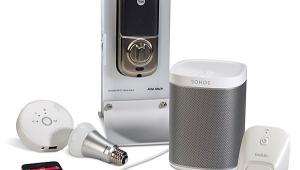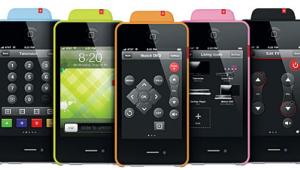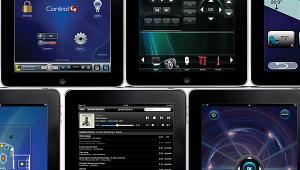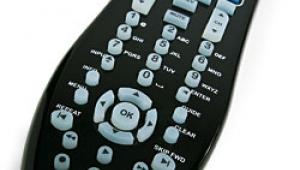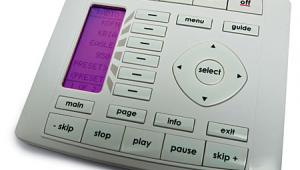Universal Remotes: Monster Central Controller AVL 300, Logitech Harmony 1000, Universal MX-3000 Page 2
After using the Monster for a week, I was more than ready to move on. Next I pulled out the Logitech Harmony 1000. This is a larger remote, more pleasing to look at because it has a large, bright, colorful LCD screen. The remote itself is brushed aluminum with a black frame surrounding its 2.75 x 2-inch screen.
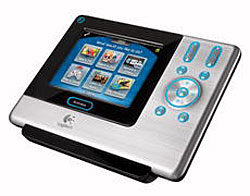 Unlike the Monster, the Harmony has very few "hard" buttons, as dedicated buttons built into the remote are called in the business. The Harmony's hard buttons are volume, channel, mute, go back one step, a four-way menu navigation control with "OK' in the middle, and separate left and right buttons. There's also a button to bring you back to the opening screen, and another to turn everything off.
Unlike the Monster, the Harmony has very few "hard" buttons, as dedicated buttons built into the remote are called in the business. The Harmony's hard buttons are volume, channel, mute, go back one step, a four-way menu navigation control with "OK' in the middle, and separate left and right buttons. There's also a button to bring you back to the opening screen, and another to turn everything off.
The Harmony remote looks neat and clean, but a good portion of the top area, perhaps one third, is empty. Why is it there? With all that empty space, one wonders, why not put in more hard controls? How about pause, or stop or menu?
In any case, I installed the software and started to set up the remote when I noticed – Logitech-Harmony uses the same software as Monster. Exactly the same. Well, I called Harmony, and it turned out that Logitech makes the remote for Monster – to Monster's specifications, of course. But the software is the same, so all the benefits and liabilities of the Monster program apply to this one, too, including the ease of setup and ability change components easily.
Once set up, it turned out that for most functions the Harmony displays a graphically pleasing suite of basic commands: Play, stop, pause, fast-forward, etc. buttons, while other controls along the side of the touch screen and in all four corners allow you to call up other menus, like a numerical keypad. The screen is large enough that it does not look crowded.
The macros turn everything on (and off) just as they should, and most of the commands for basic viewing are either among the hard buttons, on the opening screen or just one screen away. The Harmony had a much more open, pleasing and easy to use feel than the Monster, and the price is exactly the same: $499.95. With that, I cannot understand why anyone would buy the Monster. The Harmony, too, offers an RF communication system at a separate charge and can be configured to control lighting – again after buying some additional equipment.
On the Harmony, all the hard buttons were perfectly backlit. This one, too, I used on its own and found that for normal viewing I could control everything relatively easily with the one remote. A greater array of basic commands was available on screen. But for anything complex – making picture adjustments, changing other settings, as examples – it was theoretically possible with the Harmony but much easier with the component's original remote. I liked the Harmony, but I could not bring myself to put the original remotes away. So in fact, the Harmony simply added a new remote to my 17-inch-wide row of remotes. The Harmony increased the row's length to 21-inches.
Next I tried out the Universal MX 3000, a $999.95 version on this theme. It's a little bigger than the Harmony and offers roughly the same number of hard buttons. The screen is very slightly larger. It's 3 x 2.5 inches. But the biggest difference is that the Universal doesn't easily allow the end user to set up the remote. The software isn't included with the remote. The tiny bit of literature that comes with the unit directs buyers to Universal's Web site to download the software and a copy of the manual can be downloaded from there as well. Users must register online and enter the serial number of the unit to download the software.

I finally did manage to get a copy of the software, using a borrowed ID and password. But once I had downloaded the MX-3000 editor, I discovered that an "end-user" without training is lost. The software is Windows-based and functions like any other windows program. Looking at that would be like looking at Microsoft Excel for the very first time, with no background in spreadsheets and no instructions, and trying to figure out to make it work. Although a programming manual is accessible through the Help tab, the learning curve here is steep, something Universal acknowledges up front.
Universal offers half-day training for custom installers, and they have an online training program that would take at least half a day to work through (although that, too, is password-protected.) I didn't have the time or the inclination. So Universal sent over training manager Robert Durbin to set up my review sample. It took just over three hours – four times as long as it took me to set up the Monster or the Harmony- for Durbin to program, test and customize the remote to control my system. As a consumer the setup would have cost me an additional $300 to $500, maybe more, depending on the installer.
This also means that, unlike the Monster and Harmony remotes, anytime you add a piece of equipment or change your system in any significant way, you have to call the installer back to reconfigure your remote. So what do you get for all that extra money and trouble?
Well, you get the ability to customize the appearance of your remote endlessly. You can even use a photo of your choice as the wallpaper for any of the remote's "pages." You can add animations. Robert added a cartoon shark that chomped away as the remote turned on my equipment.
You can set up different control programs for different users. You can add sound, including sound effects of your choice, even verbal instructions. On screen " buttons" can take several forms and styles and be labeled however you like. And the Universal, like all the others, can be set up to transmit RF signals instead of IR.
Durbin noted that the Universal can pace the commands it issued – say, turning on the TV only after the HD DVD player has booted. He set mine up that way since the duration of HD DVD boot-up times are notoriously long.
On the day I wrote this review, it happened that The New York Times ran a review of the Harmony remote, and in it the writer quoted a custom installer, who said the Harmony (and Monster) would be adequate for a system with just a few components.
"If someone has a room with a projector on the ceiling, a drop-down screen, satellite receivers and surround sound," the installer said, "your user-programmed remote probably isn't going to be adequate."
I wonder why that is so. Both the Harmony and the Monster can control 15 components each. Before I moved last fall, I had a projector on the floor, a drop down screen, a satellite receiver, surround sound and much more. I see no reason the Harmony could not have controlled those pieces of equipment, just as it controls everything I have now. But for what it's worth, Universal claims its remote can control no fewer than 255 components.
In fact, after using the Universal I found it to be a formidable product – well made, reliable and impressive. But its basic functions – turning equipment on and controlling it – were little different than Harmony's. The screen offered different graphics that some users may or may not prefer. It is infinitely more customizable, from a cosmetic point of view, and also includes provisions for multi-zone audio. But in practical daily use in my system, I found little difference between the two.
If you care a lot about cosmetics, want a remote that can be programmed to control every function every one of your remotes (and don't mind having to call your custom installer back for a few billable hours now and then), you will like the Universal. If not, the Harmony carries out more or less the very same functions just as well – and for a lot less money and trouble.
Keep in mind that with the Monster and Harmony remotes, you'll most likely have to keep your components' remotes nearby or do some additional programming to carry out or anything beyond the basic functions. But I still found them quite handy, and if I were to buy one of the three, I would buy the Harmony.
Monster MCC AVL 300
Highs
Easy to handle
Can control lighting with added accessories
Lows
Controls can be enigmatic
Small, low-resolution screen (not a touchscreen)
No setup instructions
Logitech Harmony 1000
Highs
Easy to use once set up
Large, clear, uncrowded screen
Lows
Same setup software as Monster, with no instructions
Universal MX-3000
Highs
Vastly more flexible and configurable than the other two
Well-made, reliable, and impressively designed
Lows
No user setup
Expensive, and installer setup is an extra charge
You'll pay again for a new setup whenever your system changes





